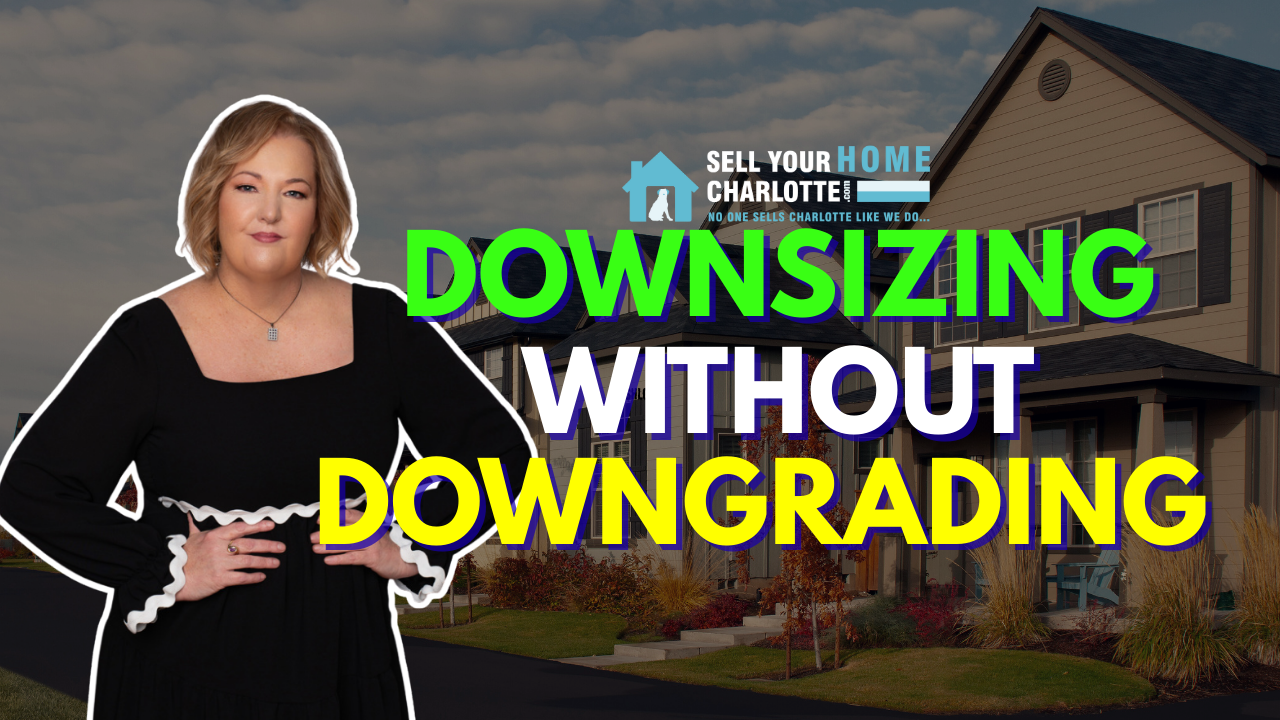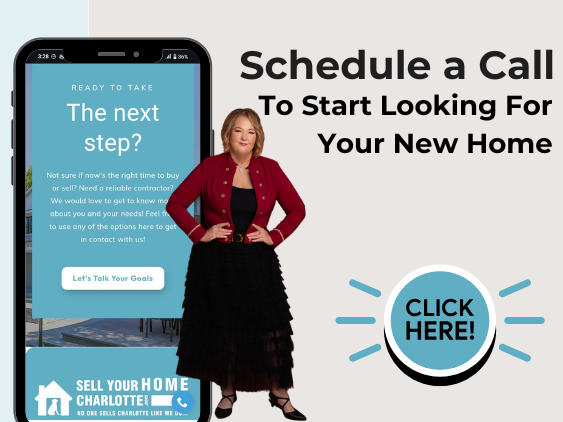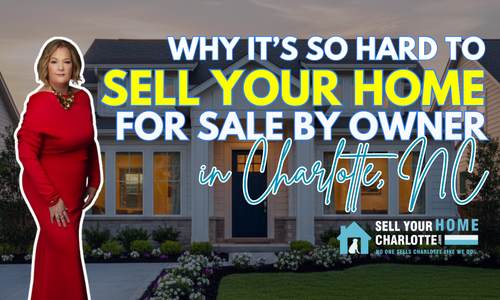Thinking about downsizing doesn’t mean giving up comfort or lifestyle. In Charlotte, it often means freeing up equity, lowering monthly expenses, and simplifying your space—without sacrificing quality of life.
I’m Maureen Mahood, Broker-Owner at SellYourHomeCharlotte. Over the years, I’ve helped dozens of local homeowners make this transition smoothly—whether moving from SouthPark to a Lake Norman condo, or trading a Ballantyne two-story for a single-level townhome near the light rail.
Here’s a practical, experience-based guide to downsizing in Charlotte—covering when to sell, what to keep, how to time the move, and how to land in a home that fits your life (and your budget).
Why People Downsize in Charlotte
For most people, downsizing isn’t just about a smaller home—it’s about living more efficiently and intentionally.
Common reasons to downsize:
- Lower monthly costs. Reducing your mortgage, property taxes, and utilities can free up hundreds per month.
- Simpler upkeep. A smaller home means less to clean, repair, or maintain.
- More accessible layouts. Ranch and main-level living are increasingly popular for homeowners who want fewer stairs.
- Unlocking equity. Many Charlotte homeowners have seen their property values grow substantially. Selling allows you to cash out equity for investing, travel, or retirement savings.
- Proximity and lifestyle. Living closer to amenities—greenways, light rail stations, medical centers, or Uptown—can simplify your day-to-day routine.
 See what your home could sell for in today’s market »
See what your home could sell for in today’s market »

The Key Numbers to Review Before You List
Before you decide to sell, take a few minutes to review your financial picture. Knowing these numbers will help you make clear, confident decisions.
Your Current Equity
Estimate how much cash you could net from selling by using:
(Estimated Market Value) – (Loan Balance + Sale Costs) = Approximate Equity
If you’re unsure of your home’s market value, request a free home valuation to get a data-driven estimate.
Projected New Payment
Include everything—mortgage, property taxes, insurance, HOA dues, and utilities. A smaller home often means meaningful monthly savings.
One-Time Moving Costs
Budget for packing supplies, movers, and basic updates or touch-ups before listing. A small pre-list investment can often yield a faster, higher sale.
Your Savings Target
A good benchmark is a 20–35% reduction in total monthly housing costs after your move. For example, if you currently spend $3,000 per month, aim to land around $1,950–$2,400.
What to Keep, Sell, Donate, or Store
Decluttering is often the hardest part of downsizing—but with structure, it becomes manageable.
Step 1: Start with the Most-Used Spaces
Focus on the rooms you use every day: kitchen, living room, and bedroom. These reflect your real lifestyle needs.
Step 2: Measure First
Before deciding what to keep, measure your new space. That beautiful dining table or sectional may not fit the new layout.
Step 3: Keep Only the Right-Size Essentials
Choose multifunctional furniture—a bed with drawers, a coffee table with storage, or nesting tables that can expand as needed.
Step 4: Sell or Donate Quickly
Local consignment stores, Facebook Marketplace, or donation centers like Habitat for Humanity ReStore make it easy to offload extras.
Step 5: Short-Term Storage—Use It, But Set a Deadline
A small storage unit can help with transition, but don’t let it linger. Plan to empty it within 90 days of your move.
 The Smart Seller's Guide
The Smart Seller's Guide

Timing the Move: Buy First or Sell First?
Timing can make or break your downsizing experience. The right approach depends on market conditions and your financial flexibility.
If Your Home Will Sell Quickly
Charlotte’s most in-demand areas—like SouthPark, Dilworth, or Matthews—often sell fast. In these cases, buying first may work best.
Options include:
- Bridge loans for short-term financing
- Extended closing periods that give you time to sell
If Your Home May Take Longer to Sell
If your property is unique or in a slower-selling area, it’s often smarter to sell first.
You can request a rent-back agreement (up to 60 days) so you don’t have to move twice.
Goal: One move, minimal overlap, and no double payments.
Charlotte Neighborhoods and Home Features Downsizers Love
Every downsizer’s “must-have” list looks different, but certain features tend to rise to the top.
Top Home Features
- Main-level living or master-on-main
- Smaller, well-designed floor plans (1,500–2,000 sq. ft.)
- Low-maintenance yards or HOA-included landscaping
- Walkable access to grocery stores, parks, and restaurants
Charlotte Neighborhoods Popular with Downsizers
- SouthPark: Upscale condos and single-story homes close to shopping and dining.
- Dilworth / Myers Park: Charming bungalows and proximity to Uptown.
- Ballantyne: Newer construction, golf courses, and active-lifestyle communities.
- Lake Norman & Cornelius: Waterfront townhomes and lake-access condos.
(All housing information shared in compliance with Fair Housing laws.)
Selling the Current Home: What Really Makes an Impact
When preparing your home for sale, not all upgrades are worth the cost. Focus on updates that maximize first impressions.
- Neutral paint, clean flooring, and updated lighting give your home a fresh feel.
- Professional photos and a short walkthrough video attract serious online buyers.
- Price for today’s market, not yesterday’s memories. Emotional pricing can cost you time and offers.
- Flexible showing hours make your listing accessible to more potential buyers.
- Consider a pre-listing inspection to resolve surprises before negotiations.
 Selling with Maureen
Selling with Maureen

Buying the Next Home: Checklist for Comfort and Fit
Once your current home is under contract, it’s time to find a new place that fits your lifestyle.
What to Look For
- Right-sized space—enough for your daily routine without excess rooms.
- Ample storage—pantry space, closet organizers, or garage shelving.
- HOA details—review fees, reserves, and maintenance coverage.
- Comfortable all-in monthly cost—include utilities and HOA dues, not just mortgage payments.
 Home Search
Home Search
Local Tips to Make Downsizing Easier
- Visit your target neighborhood at different times of day. Traffic and activity can vary.
- Prioritize function over nostalgia. Keep items that serve your daily life.
- Plan one donation pickup per week. Keeps momentum without overwhelm.
- Use a local moving company familiar with Charlotte neighborhoods to minimize logistics headaches.
Frequently Asked Questions (FAQs)
1. When is the best time to downsize in Charlotte?
Spring and early summer are typically ideal, but Charlotte’s strong year-round demand means fall and winter moves can still bring solid offers.
2. How long does the downsizing process take?
Most clients take 3–6 months from listing to closing on their next home, depending on inventory and prep time.
3. Should I renovate before selling?
Stick to light cosmetic updates—fresh paint, lighting, and hardware. Avoid large renovations unless they significantly raise market value.
4. How do I avoid feeling cramped in a smaller home?
Choose homes with open layouts, good natural light, and built-in storage. Functionality matters more than square footage.
5. What’s the average cost of downsizing in Charlotte?
Expect to spend roughly 6–8% of your home’s sale price on selling costs (commissions, fees, and closing), plus moving expenses.
6. Can I buy before I sell without two mortgages?
Yes—with a bridge loan or home equity line of credit (HELOC). A lender can help assess if it’s the right fit for your situation.
Thinking about downsizing in Charlotte in the next 3–6 months? Let’s review your numbers, your goals, and a shortlist of homes that fit your lifestyle perfectly.



 Maureen@SellYourHomeCharlotte.
Maureen@SellYourHomeCharlotte.



